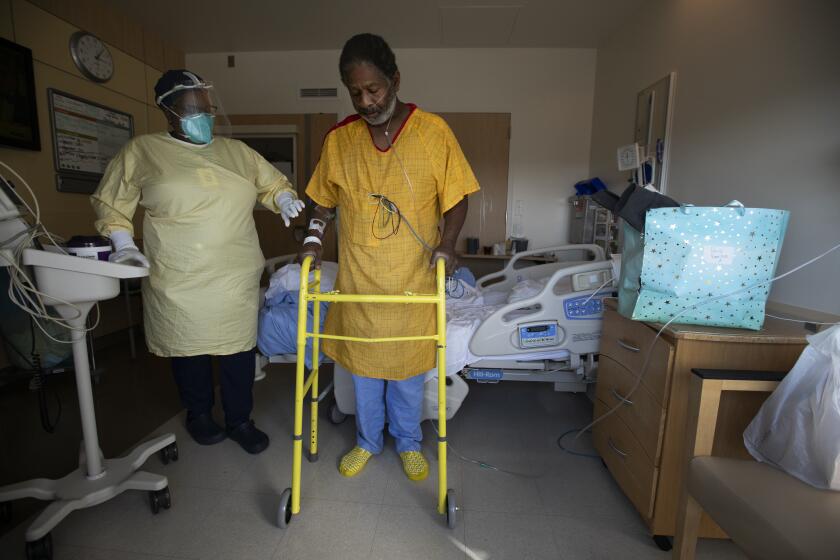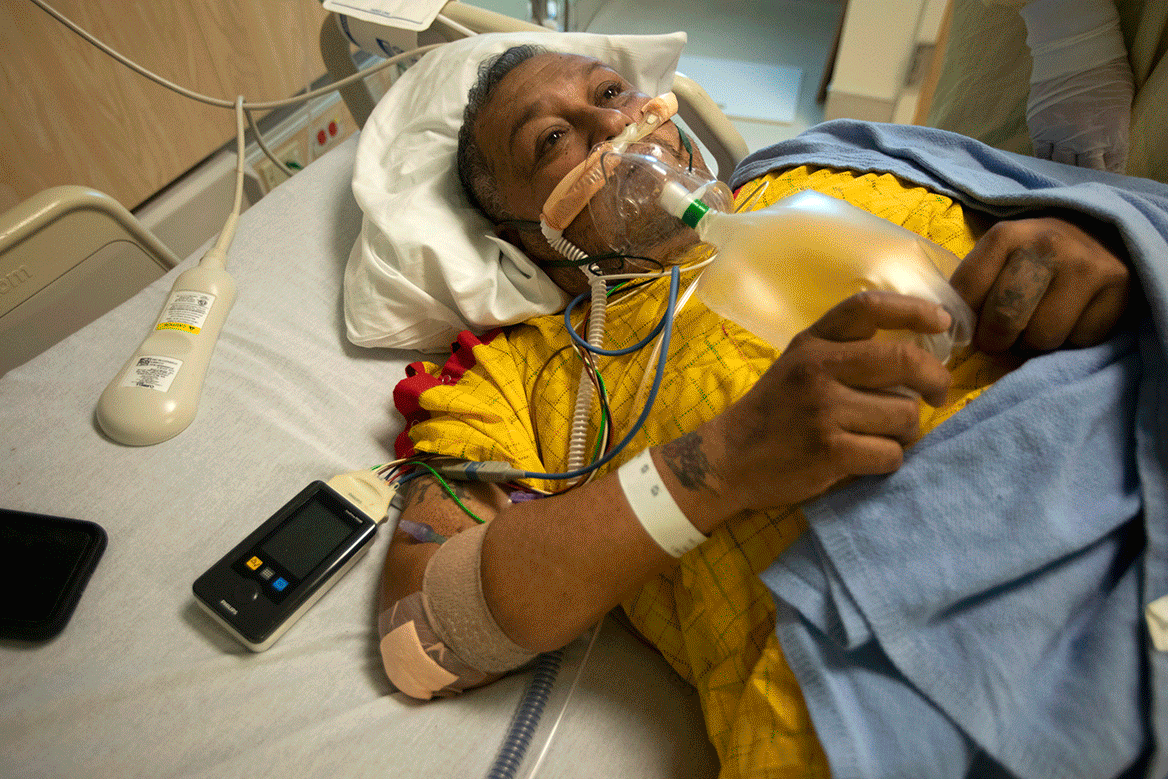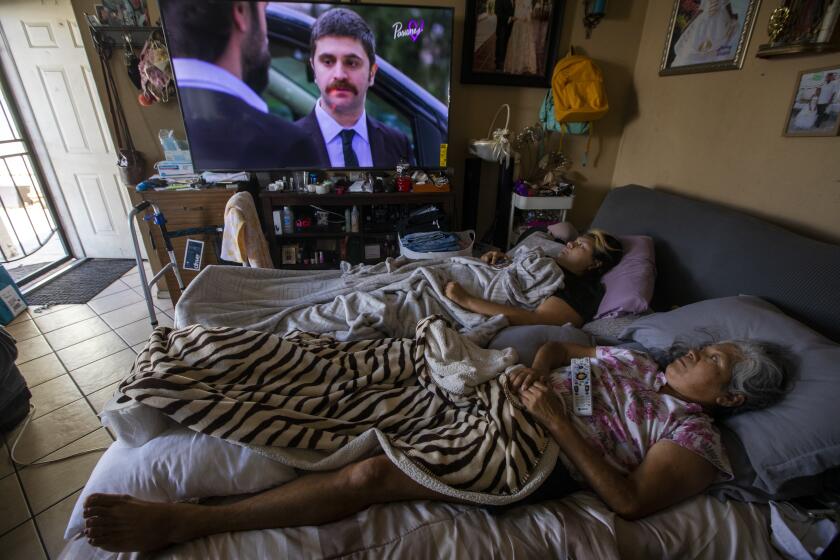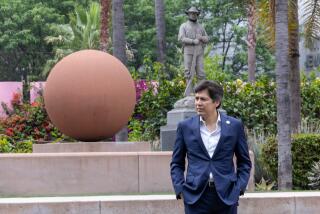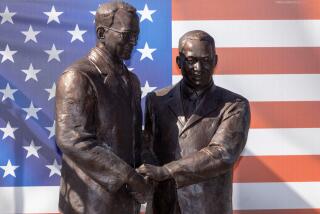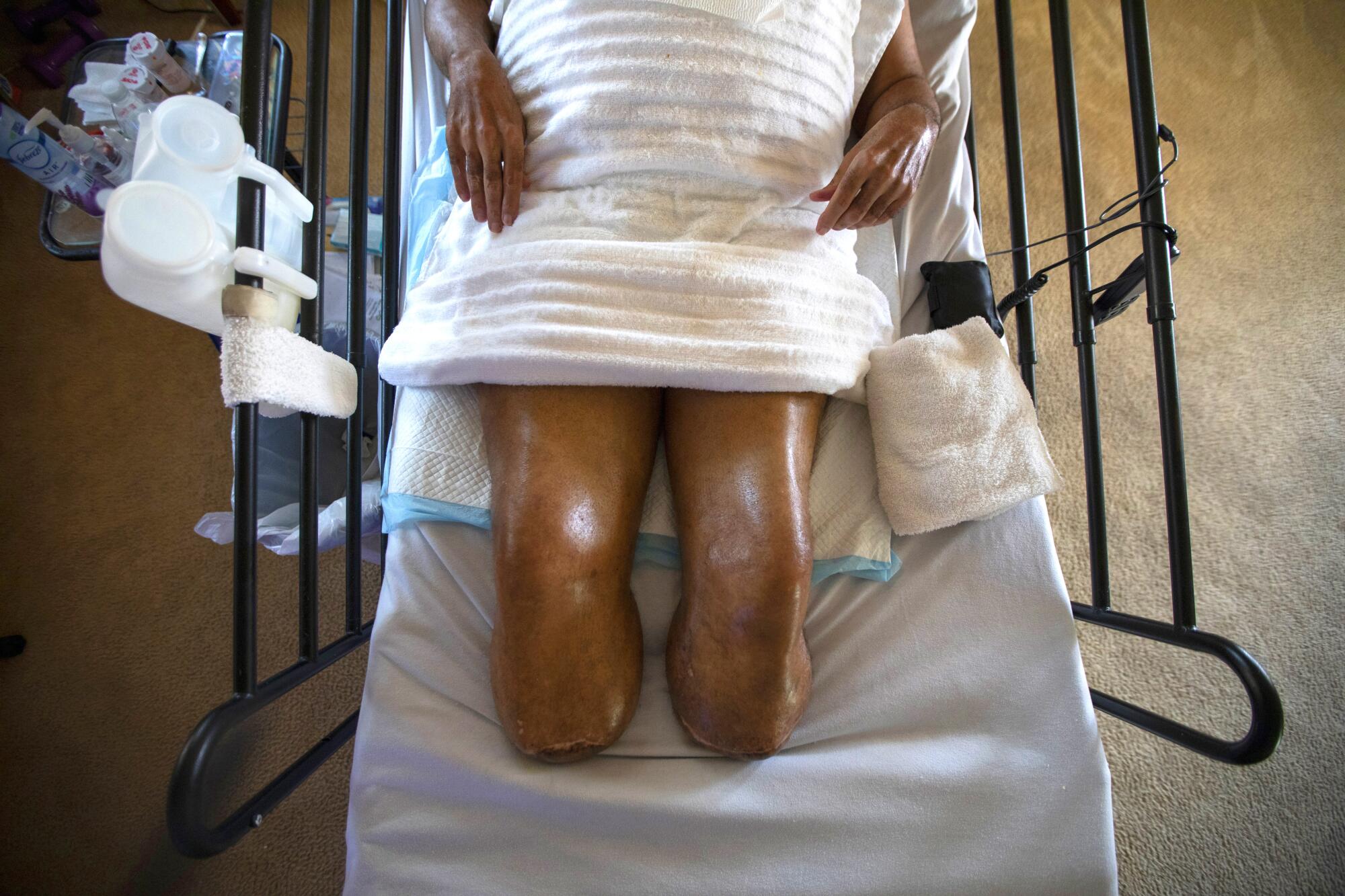
Her small toe was turning purple, and the pain was excruciating. Glory Paschal knew how fast this could spiral. She just had to look around her neighborhood in Watts to see how many residents were missing feet and legs.
She fought for a referral to a podiatrist, but by the time she saw one, it was too late.
On Feb. 10, 2011, doctors at Harbor-UCLA Medical Center had no option but to amputate her left leg below the knee.
This summer, the now 53-year-old Black grandmother was back in the hospital, this time with two infections particularly lethal for a diabetic: severe COVID-19 had her gasping for breath and gangrene was eating away at her remaining foot.
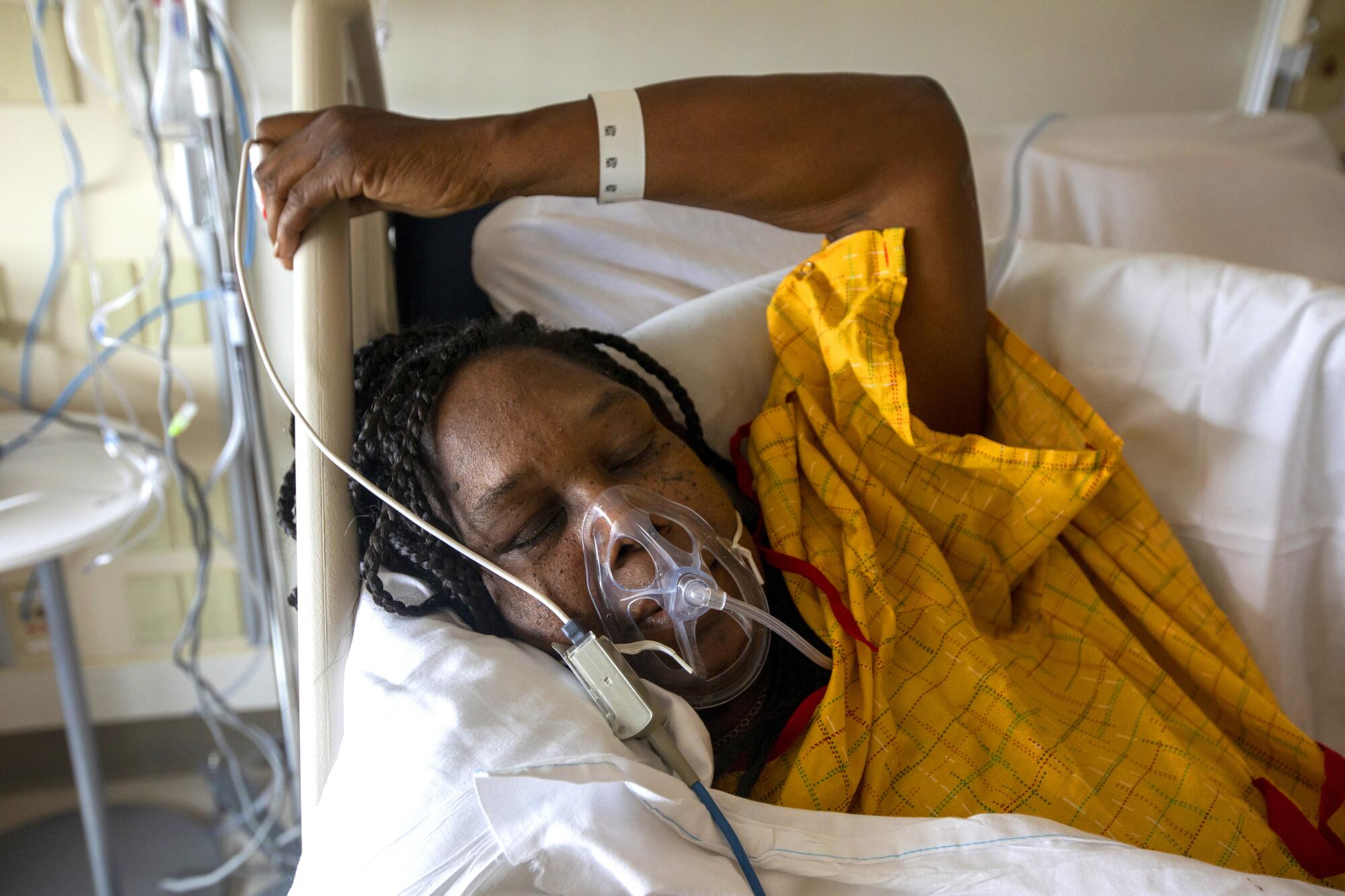
The coronavirus piggybacked on a catastrophe of poorly treated chronic illnesses rampant in South L.A.: heart disease, high blood pressure, lung cancer, kidney disease, asthma, arthritis, depression. And diabetes.
All of this made South L.A. a hotspot of COVID-19 deaths during the winter surge. But while that deadly wave receded, the high tide of underlying conditions remained, with Black and Latino residents facing nearly unrivaled numbers of diabetic amputations.
The loss of limbs embodies the enduring grief of generations in South L.A. — of entrenched poverty, the dearth of both supermarkets with fresh food and parks to promote exercise, and a deeply deficient primary healthcare system that relies on low payouts from the state’s Medi-Cal program and a scant number of qualified doctors.
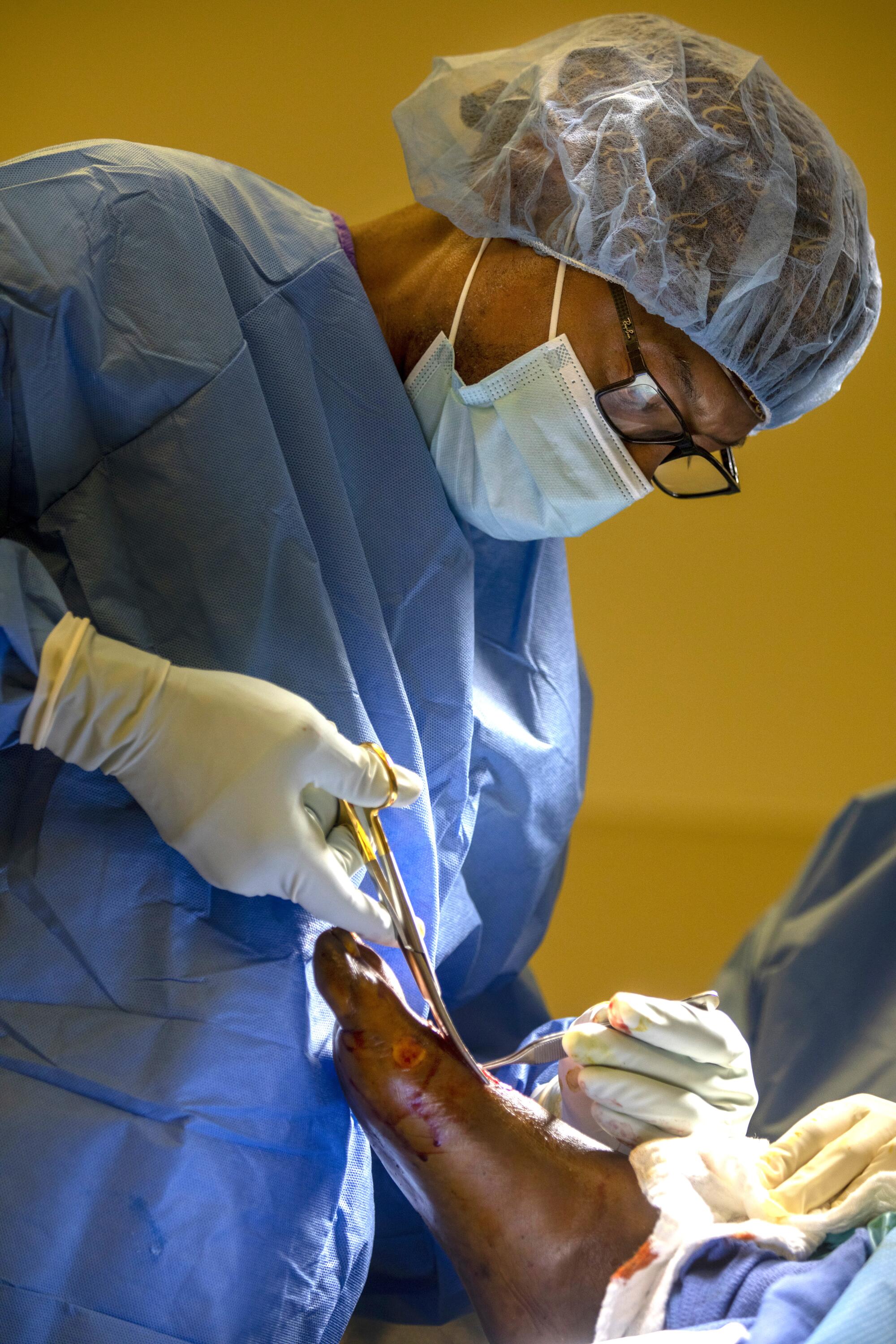
“The tragedy is our community lacks almost every type of healthcare that you can think of and that most of us take for granted,” said Dr. Elaine Batchlor, the chief executive of Martin Luther King Jr. Community Hospital.
She said despite the efforts of her privately funded, high-tech hospital, the people of South L.A. are largely getting preventive care that is “separate and unequal.”
Nobody, Batchlor said, should have to live in a community “where you couldn’t go to the pharmacy and get the medicines that your doctor prescribed.”
“We wouldn’t live in a community where you couldn’t get urgent care. We wouldn’t live in a community where you couldn’t get an appointment to see your doctor for weeks or months,” she said. “But that’s what we’ve got in this community.”
When Paschal visited her primary care doctor in Lynwood for her toe pain, he told her she just had a case of athlete’s foot and sent her home with cream.
When she returned multiple times asking for a referral, the doctor told her she was “nothing but a problem.”
“You’d be better off if they cut your foot off,” she recalled him saying.
She eventually got an appointment with a foot specialist for $50. “You need to go to the emergency room right now,” he said.
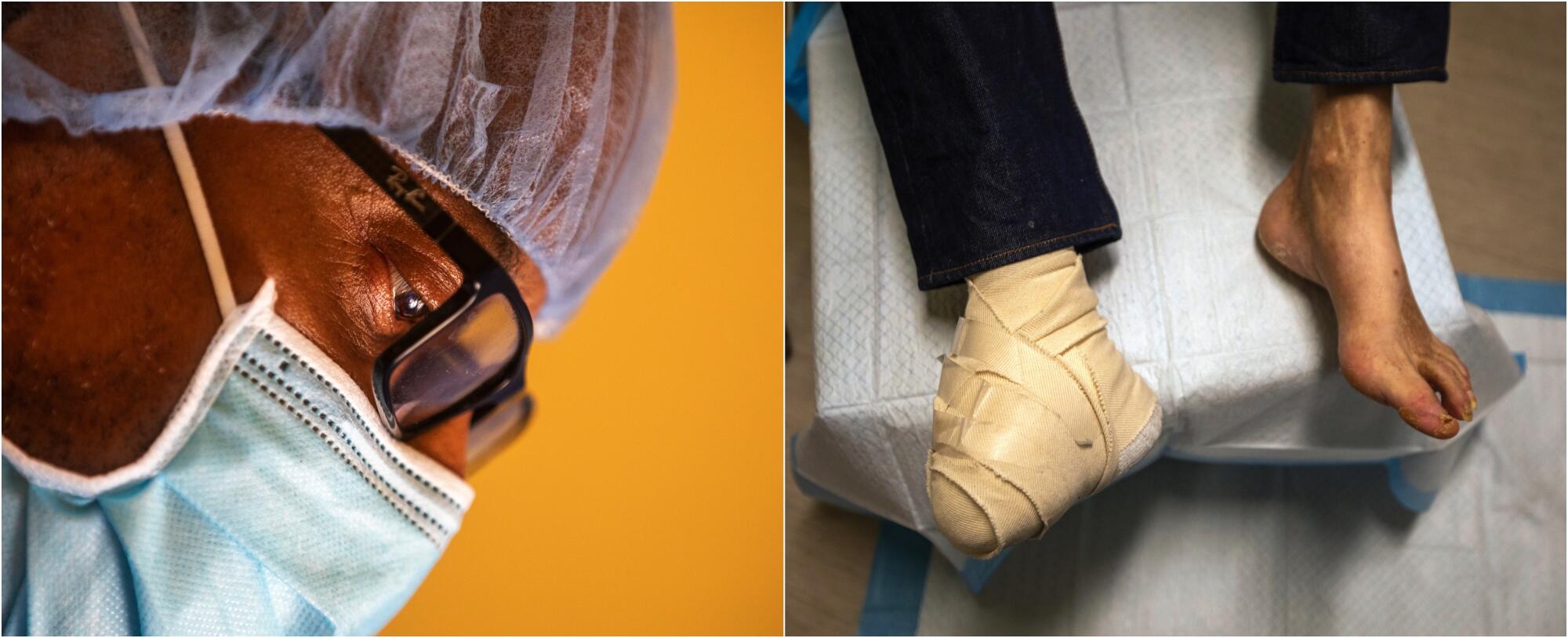
Dr. Myron Hall has heard the story of this same cascade of failure too often to count. As a Black podiatrist at MLK hospital, he has devoted the last five years to salvaging limbs and lives.
Among his patients: Tony Zamora, 45, of Compton, was falling down the same hole as his dad, who lost both legs and died two years later. Bill Crawford, 66, has been lying in bed in Watts for two years after his two below-the-knee amputations, fighting kidney stones while waiting to get the physical therapy he needed to learn to use prosthetic limbs and walk again. Paschal was trying to preserve her remaining foot and survive COVID-19.
Richard Perry, who by his own sheer grit built a middle-class life for his family in Compton, was waging battle on two fronts: Fighting against COVID-19, and trying desperately to hold on to everything he had worked for.
At MLK hospital, amputations are the most common surgical procedures. Researchers at UCLA found that diabetic residents here and other poor parts of the city were more than 10 times as likely as those in more affluent areas to have a toe, foot or leg amputated.
The high blood sugar associated with diabetes does its damage to organs and limbs by clogging arteries. In the feet, this means minor wounds don’t have the blood flow to fight off microbes, and small infections can turn lethal.
Removing the infected parts is too often the last resort — a decaying toe or two, then the metatarsals, then a foot or a leg. The decline in mobility can lead to social isolation, depression and the further deterioration of health. Studies show that between 52% and 80% of diabetic patients who get a below-the-knee amputation die within five years.
At the root of the health crisis in places like South L.A. is inadequate health insurance. Many residents have none or are enrolled in Medi-Cal, the state’s Medicaid program, which pays doctors about half of what Medicare pays for the same service. Many doctors won’t accept it.
For many patients, intubation can be a last effort to stave off death. But that doesn’t mitigate how terrifying the experience can be.
A survey conducted by MLK hospital last year found that its service area of more than 1.3 million people had only a third of the full-time physicians required to adequately treat that population — a shortage of 1,300 doctors.
“There is no question that the healthcare disparities that we see across America and certainly in places like South Los Angeles are the long-standing results of systemic racism,” said Darnell Hunt, dean of social sciences at UCLA and co-editor of “Black Los Angeles: American Dreams and Racial Realities.”
The inequities are the heritage of a city’s drive, for 80-some years, to geographically segregate people of color with its own brand of Jim Crow, particularly as tens of thousands of Black people began arriving from the South during World War II.
Restrictive housing covenants and racist real estate agents kept Black families from moving out of South L.A. Redlining of the area prevented them from getting loans for homes and businesses. Black residents faced discriminatory hiring, second-rate schools and militaristic policing that became notorious for its abuses.
The policies effectively platted South Los Angeles as a zone of enduring inequity for subsequent waves of immigrants, whether from Louisiana, Mexico or El Salvador.
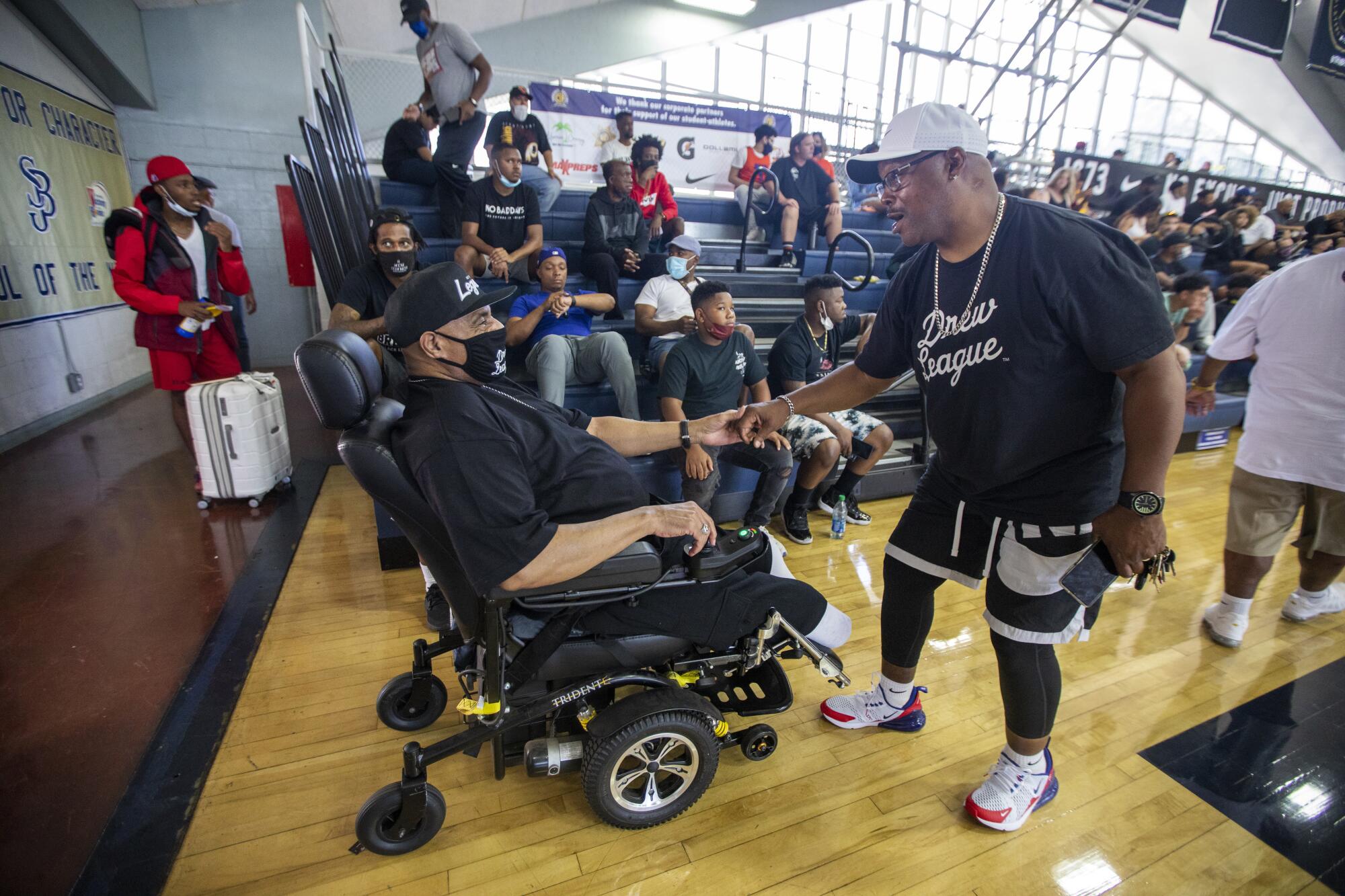
::
When Bill Crawford’s family came to Los Angeles from New Orleans in 1957, they moved to Watts. His dad was a Baptist preacher and became one of the few Black sheriff’s deputies at the time. His mom taught at Carver Middle School.
The neighborhood was a peaceful, friendly place of interconnected Southern families and plenty of local businesses. Across the street from his home on Compton Avenue was a jewelry store, a clothing shop where his mom bought his church clothes and a big supermarket where his dad helped cut the meat.
A Los Angeles couple has worked hard to eke out a living and provide for their daughter, who is trans. When COVID hit, they feared who would protect her after they’ve gone.
Crawford was a football star at Jordan High School, until he shattered his hip. That thwarted his prospects for a full-ride scholarship to USC, but he paid his way through Cal State Fullerton and later became an English teacher and coached football and basketball at Fremont High School.
On the side, he and his friends started a nighttime pickup game of basketball in the gym at Charles H. Drew Middle School that evolved into the famous Drew League, a pro-am summer league drawing such luminaries as Kobe Bryant, LeBron James and Kevin Durant. Crawford was the league’s announcer for 22 years and coached for 27.
His old friends call him “Still Bill” because he’s solid, never changing.
“The game doesn’t start until Bill comes in,” said Dino Smiley, chief executive of the league. “He’s our No. 1 legend.”
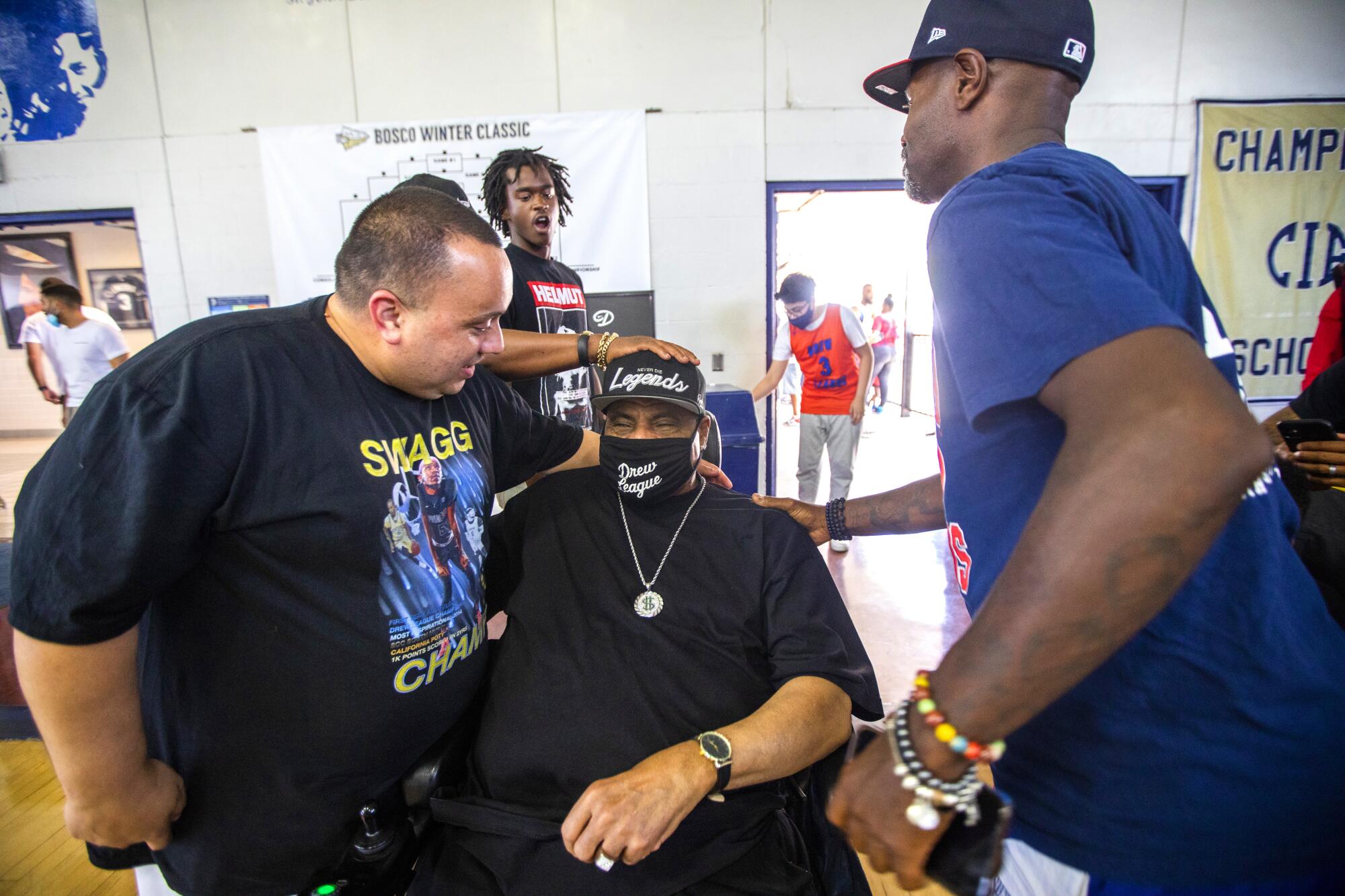
Crawford moved to Upland to get away from “all the drama, the gang stuff, the police brutality” in the 1980s but was commuting to his job in Watts and attended every Drew event.
At age 35, he was diagnosed with diabetes. The disease had already damaged his retina and he lost his sight for a month. He was also developing deep vein thrombosis in his legs and arthritis where he broke his hip.
He and his wife and two young daughters moved back to Watts so he could be near the Kaiser Permanente medical offices in Bellflower. Doctors there got his blood sugar under control and saved him after a pulmonary embolism in 2008. When he retired at 55 and shifted to Medi-Cal insurance, he started getting treatment at a local clinic.
To treat his deep vein thrombosis, the clinic sent him to a specialist in downtown Long Beach, who told him he needed a stent to open up an artery in his leg. But he never got the approval for the procedure that might have saved his feet. As his circulation diminished, he quit playing basketball and found it harder to walk.
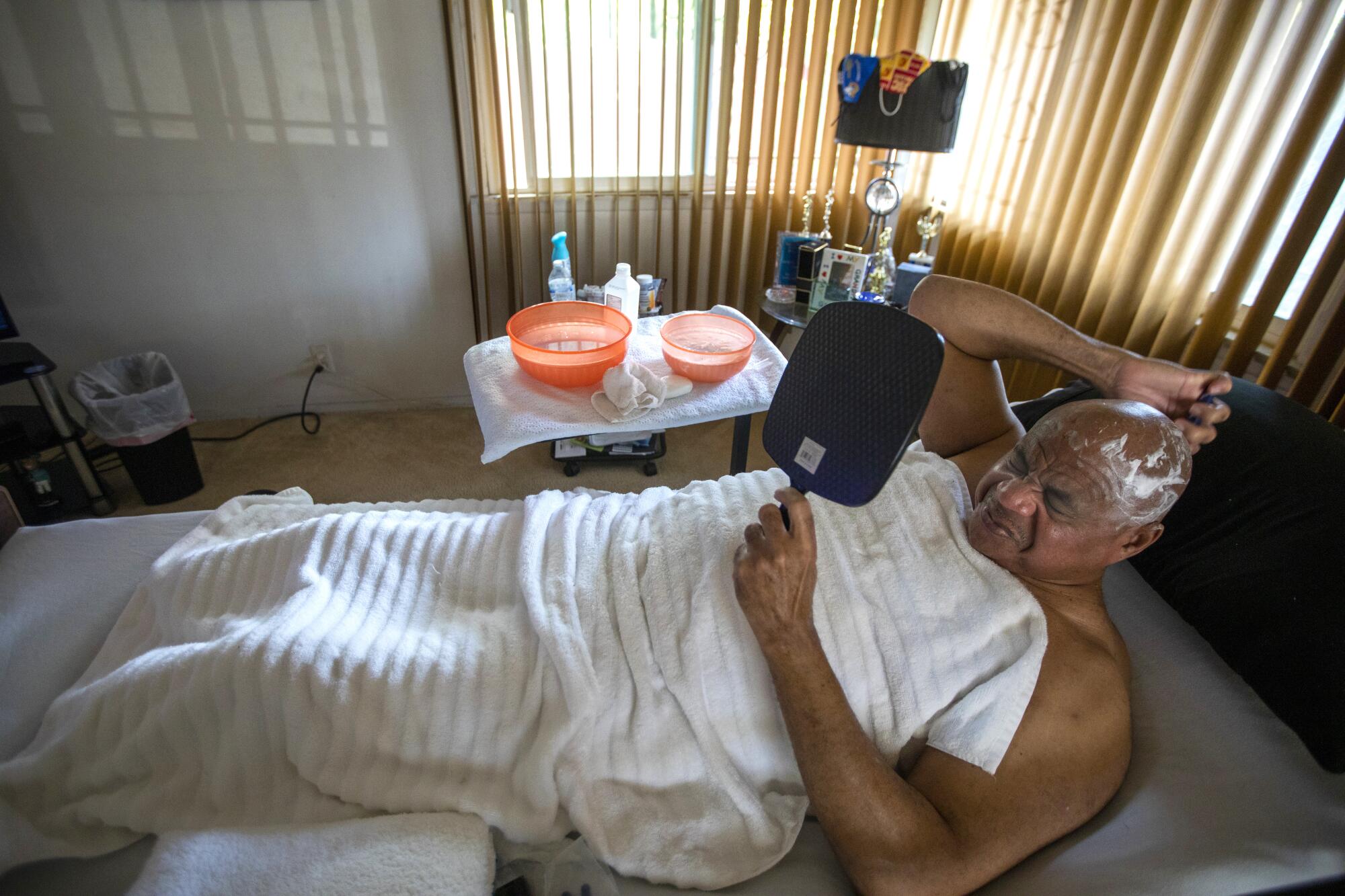
One morning his wife noticed his foot was bleeding. Because the diabetes had caused a loss of sensation in his legs, Crawford hadn’t realized there was a wound. A tack had been stuck in the bottom of his slipper for who knows how long.
For two years, he cycled through doctor’s offices and hospitals.
“We’d rather have no feet than no dad.”
— Crawford’s youngest daughter
At the Drew League championship in 2017, with Bryant and actor Jamie Foxx in attendance, Smiley made an announcement about a gift for a special guest.
“Knowing him the way I do, he probably don’t want no wheelchair,” Smiley said. “But we got it for him anyway.”
Crawford beamed, feeling all the love he put into the league returned to him.
Crawford first saw Hall on Dec. 21, 2017, with a massive ulcer where the pin-prick had been. The two hit it off. They were both sports junkies and high school football standouts.
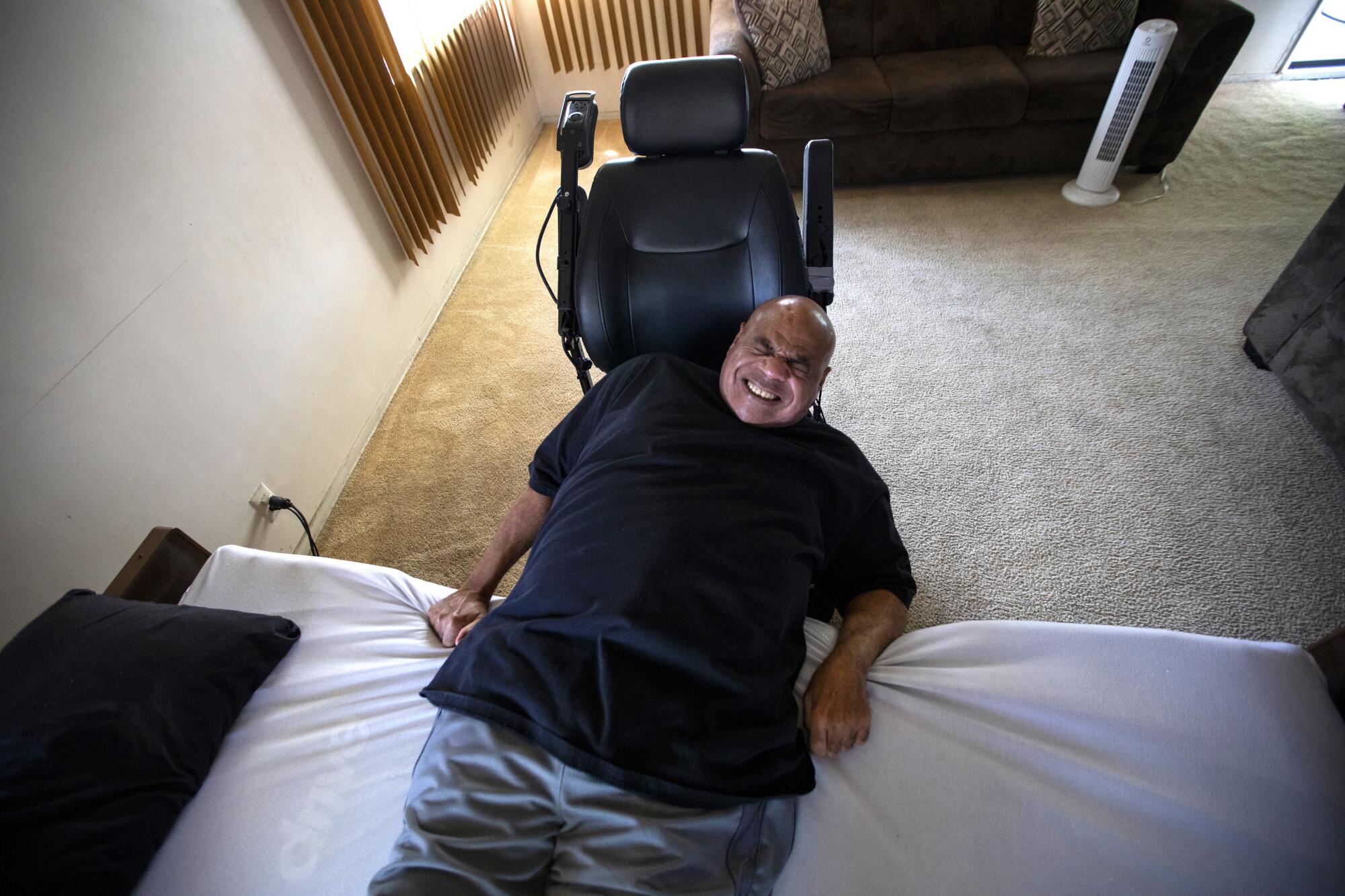
Hall took some scissors and a scalpel to remove infected and dead tissue — debriding the wound — and had him return repeatedly over several months.
But it was late in the game. A home nurse nicked his other foot, and that wound got infected. Crawford was put on a catheter with antibiotics for six weeks and Hall kept debriding. But the infection was creeping into his bones and could kill him.
“We’d rather have no feet than no dad,” his youngest daughter said.
Doctors cut off Crawford’s right leg below the knee in November 2018 and removed the left one three months later.
Because of delays in treatment, Crawford hasn’t been able to get approval for the physical therapy he needs to walk on his prosthetic legs, which have been sitting in his garage for two years.
Crawford lies in bed surrounded by photos of his five daughters and the college and graduate degrees of his most academic child: from UC Berkeley, USC, UCLA.
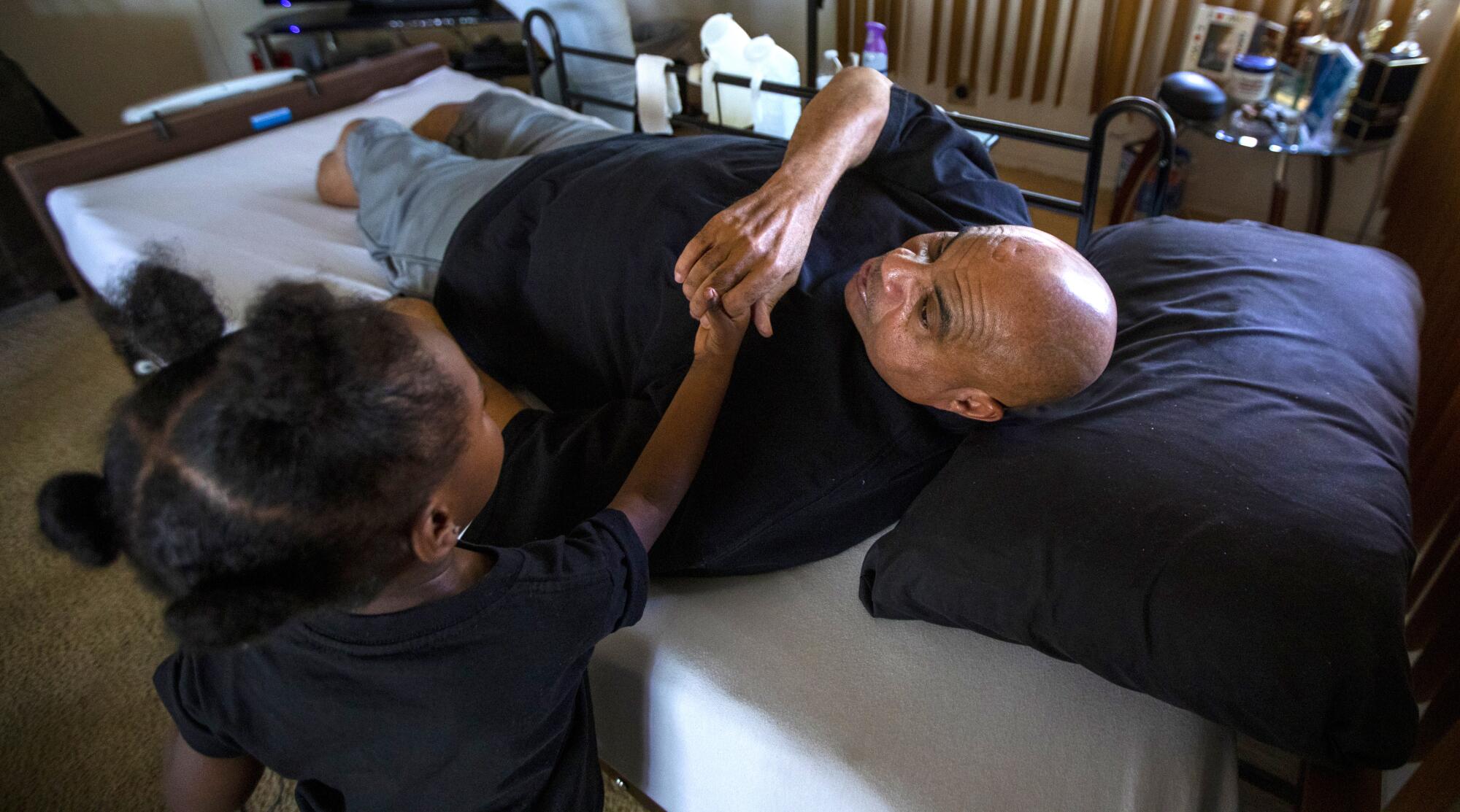
His girls are his biggest motivation to continue the fight.
“Get me going, that’s all I want,” he says.
Hall never expected to be dealing with matters of life and death when he decided to go into podiatry. He thought he’d be mostly doing sports medicine.
After an early career as a naval officer, Hall worked at the Kaiser Permanente facility in Fontana before opening a private practice in Beverly Hills, with staff privileges at Cedars-Sinai Medical Center, where he does complex foot and ankle reconstruction surgeries. But he promised his mother, Gloria, that he wouldn’t just treat the rich. He knew poverty firsthand. He and his mom lived for a spell in the back of a restaurant and bar Gloria owned in Tennessee when she couldn’t pay the mortgage on her house. He can still smell the specialty — fried whiting fish.
When Hall was a running back in high school and she was chaperone for the cheerleaders, Gloria would run down the sideline with him.
“Don’t look back!” she yelled. “Why are you looking back? They can’t catch you.”
She died six years ago from respiratory failure, but her sideline voice rings in his ear every day. He started doing house calls in South L.A. and Compton, then opened a second practice out of Martin Luther King Jr. hospital in 2016. He often does rounds at MLK hospital at 4 a.m., drives to Beverly Hills when the morning traffic dies down and returns to MLK hospital to do a surgery at night.
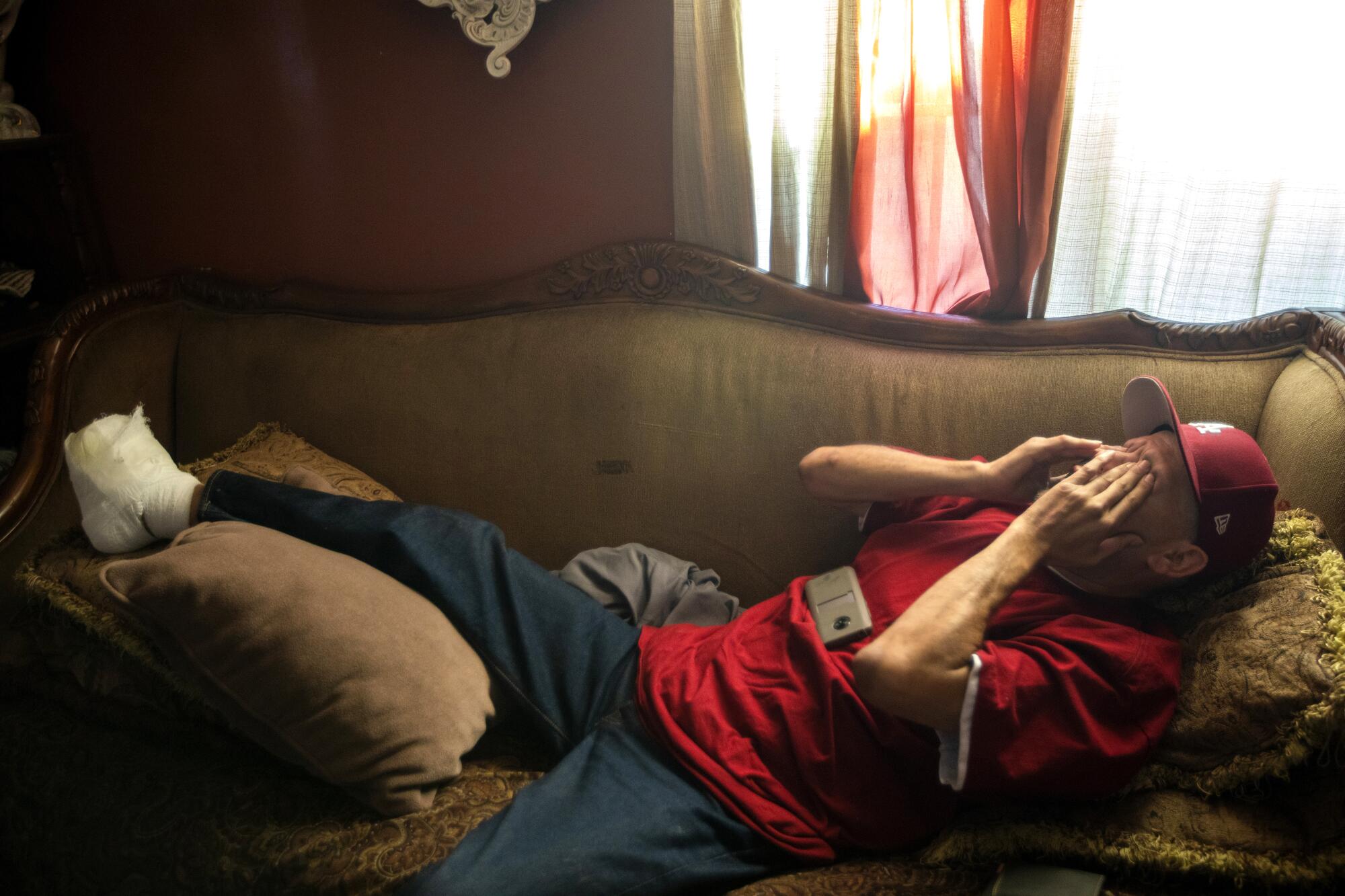
::
Tony Zamora first visited Hall at an MLK clinic in Compton in 2019 with a blister on the side of his foot. Hall debrided and treated it with antibiotics. But Zamora’s coverage plan didn’t provide daily nurses to take care of the wound and the infection worsened. His big toe was turning black. On Zamora’s next visit to the clinic, Hall could smell the decay as soon as he opened the door of the examination room.
He amputated the toe and cleaned out all the other infected tissue he could see. Rather than cut off the entire foot to ensure the infection would not spread, Hall checked and debrided the wound. He tried keeping the infection down with antibiotics.
Zamora knew how quickly these losses accrued. He still grieved his father, Rafael, who died two years after losing his second foot at 61.
His dad’s death sent Zamora into a tailspin that ultimately led to a divorce and several years of drinking, meth use and homelessness. “He was the most important person in my life,” he said.
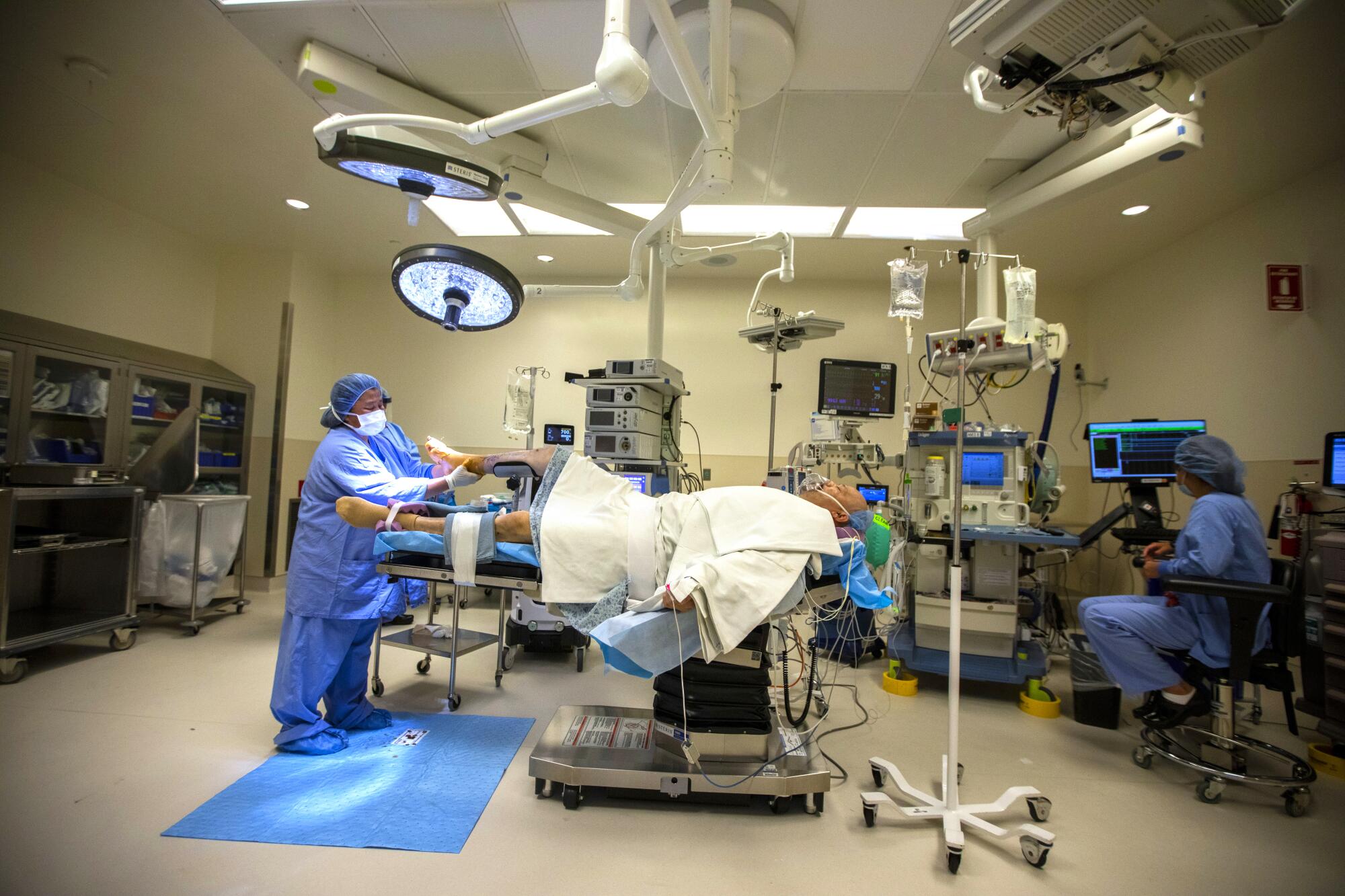
During that time, Zamora’s own diabetes went untreated and led to peripheral artery disease and a loss of sensation in his feet. But by the time he reached Hall, he had marginally pulled his life together and was working as a forklift driver and living in a tent in the back of his mother’s house.
After Hall removed his big toe, Zamora needed to be vigilant: Wear diabetic shoes, check his feet every day, keep his sugar and blood pressure down.
But he was distracted, devastated about his toe, missing his wife and two children, who were living near San Bernardino.
To get him out of his funk, his mother took him on a trip in April to her hometown in Mexico. He started drinking with his cousins and walked all over the village in regular shoes. He came home with an open wound covering most of the ball of his foot.
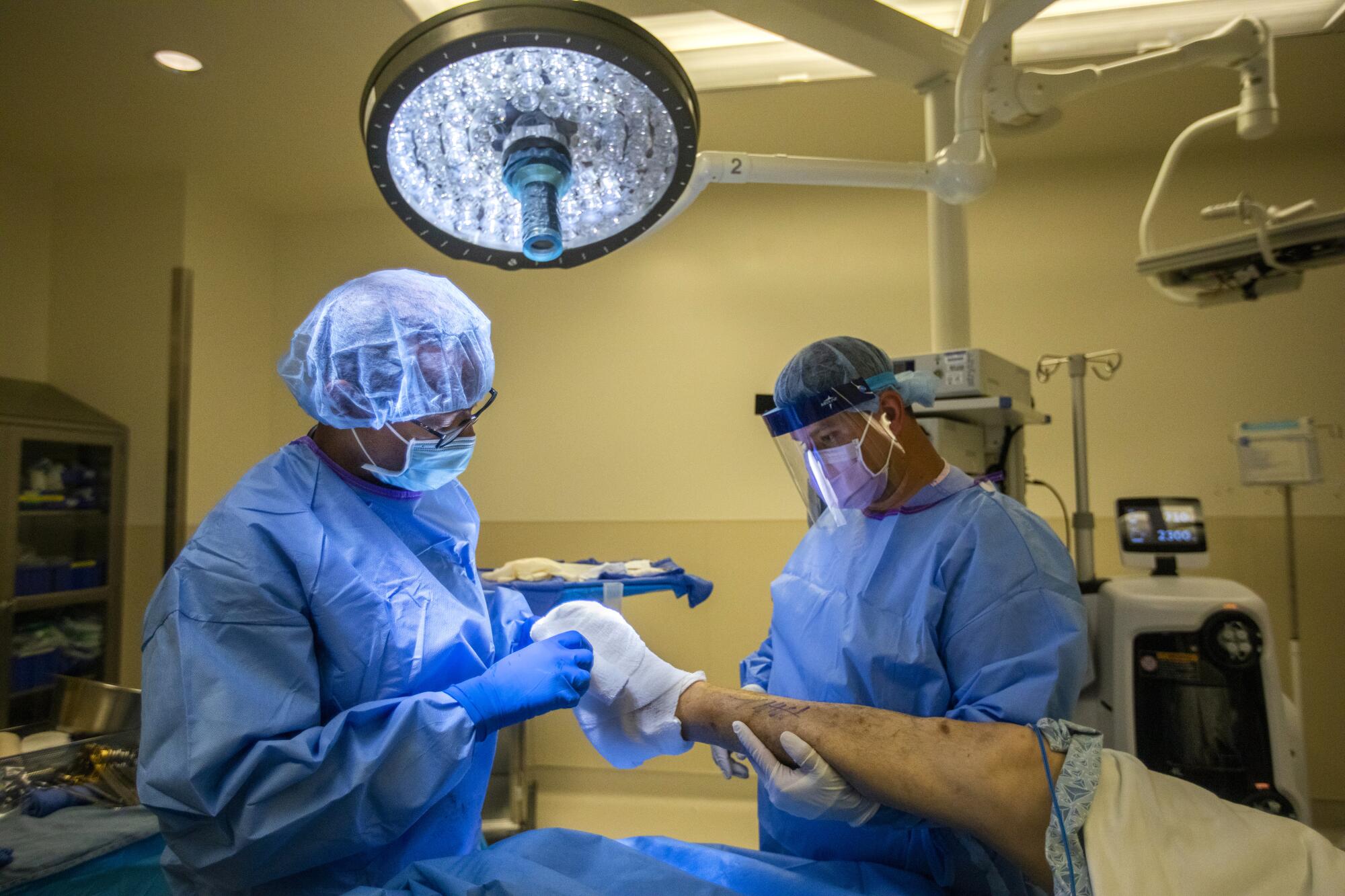
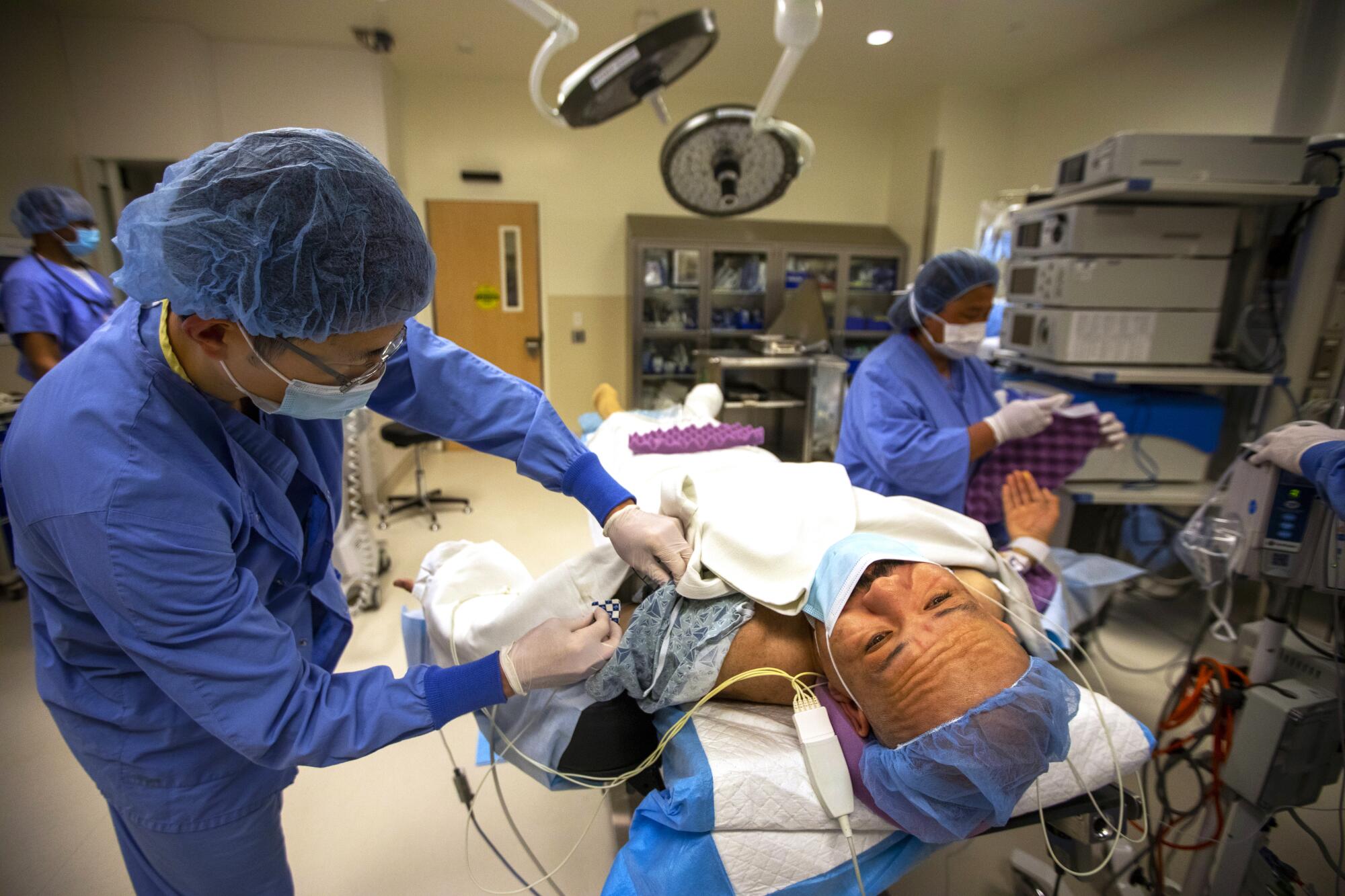
When he was told by his insurance that he would have to have the surgery at a different hospital than MLK, Hall intervened and got him approved to have it done as an outpatient procedure. Zamora came in at 6 a.m., had the bad tissue cut out and went home at noon.
One night, Zamora fell going to the bathroom and bashed the wound. More surgeries followed, and he lost a second toe. When he came to the emergency room on June 2 in severe pain, his condition was so dire that Hall ordered that he not be transferred to a different hospital
That night in the operating room, the doctor prayed and washed up for surgery.
“He’s got air bubbles under his skin and that’s one of the obligatory emergencies we have,” Hall told The Times. “If you have gas, you have gas gangrene and possibly necrotizing fasciitis, which is the flesh-eating bacteria that is life-threatening.”
Hall removed his remaining toes, and all the metatarsals — the front half of the foot.
If he didn’t lose more, Zamora could wear a shoe filler and walk on that leg.
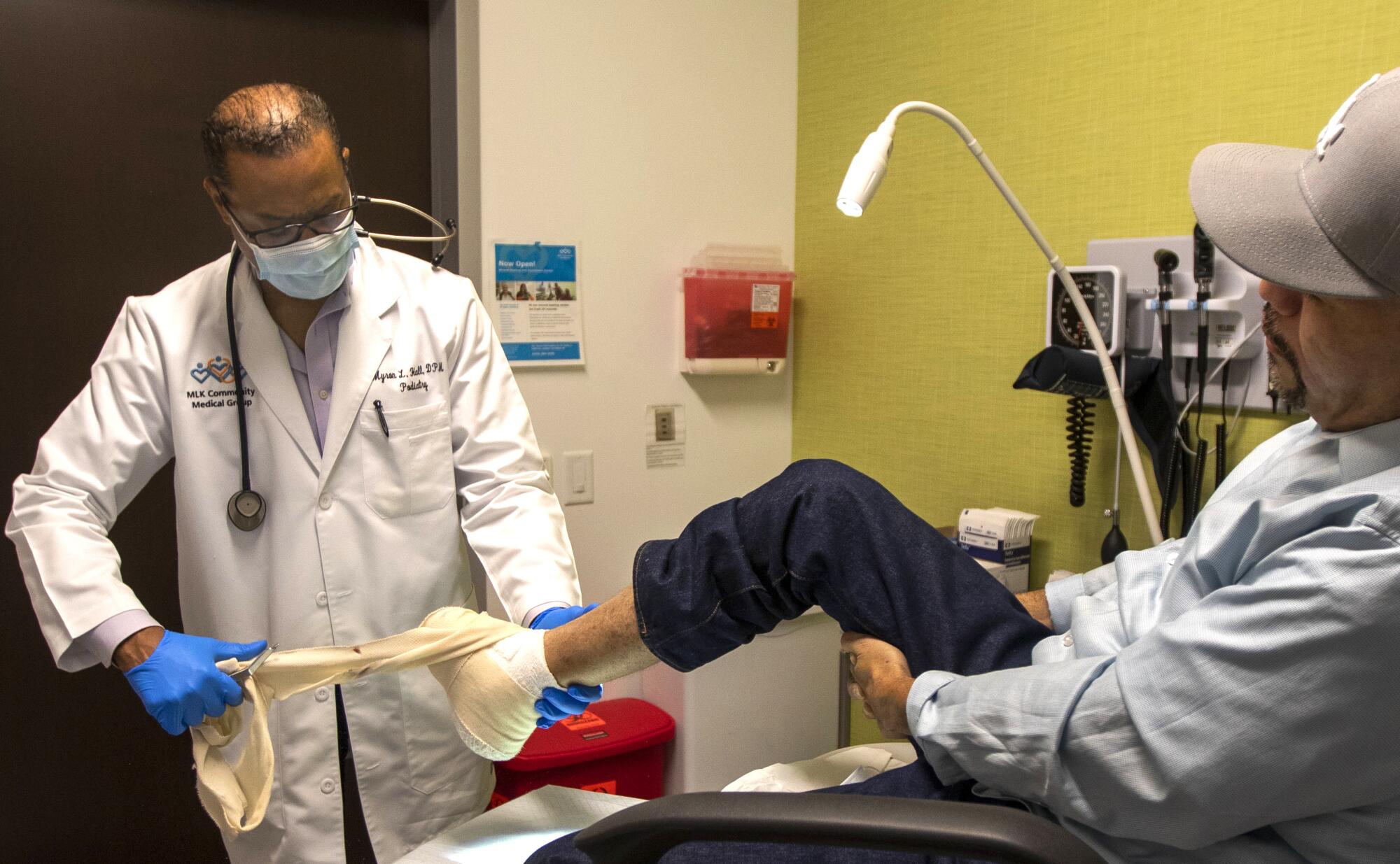
But he struggled with his diet. This month, Zamora’s blood sugar was dangerously high and his leg was swelling up with a new infection. He was back at MLK hospital on a catheter line of antibiotics to save his life.
::
After Glory Paschal’s leg was amputated in 2011, she switched primary care doctors but battled to get adequate treatment through him and his network. She relied on the emergency room instead. The ER at MLK hospital was designed to treat 40,000 people per year; it sees 100,000. About 40% of its patients are seeking primary care.
Paschal went there in September 2020, feeling sick and exhausted. A vascular surgeon, David Tobey, told her that her kidneys were failing and hooked her up with peritoneal dialysis. In February, Tobey did an angioplasty to restore blood flow in her right leg, and had Hall look at her feet.
Paschal, who came to California as a 4-year-old from Magnolia, Ark., showed a grit that reminded Hall of his mother’s determination. But when she dropped the cantankerous front she needed to fight for her medical care, she was warm and sharply funny.
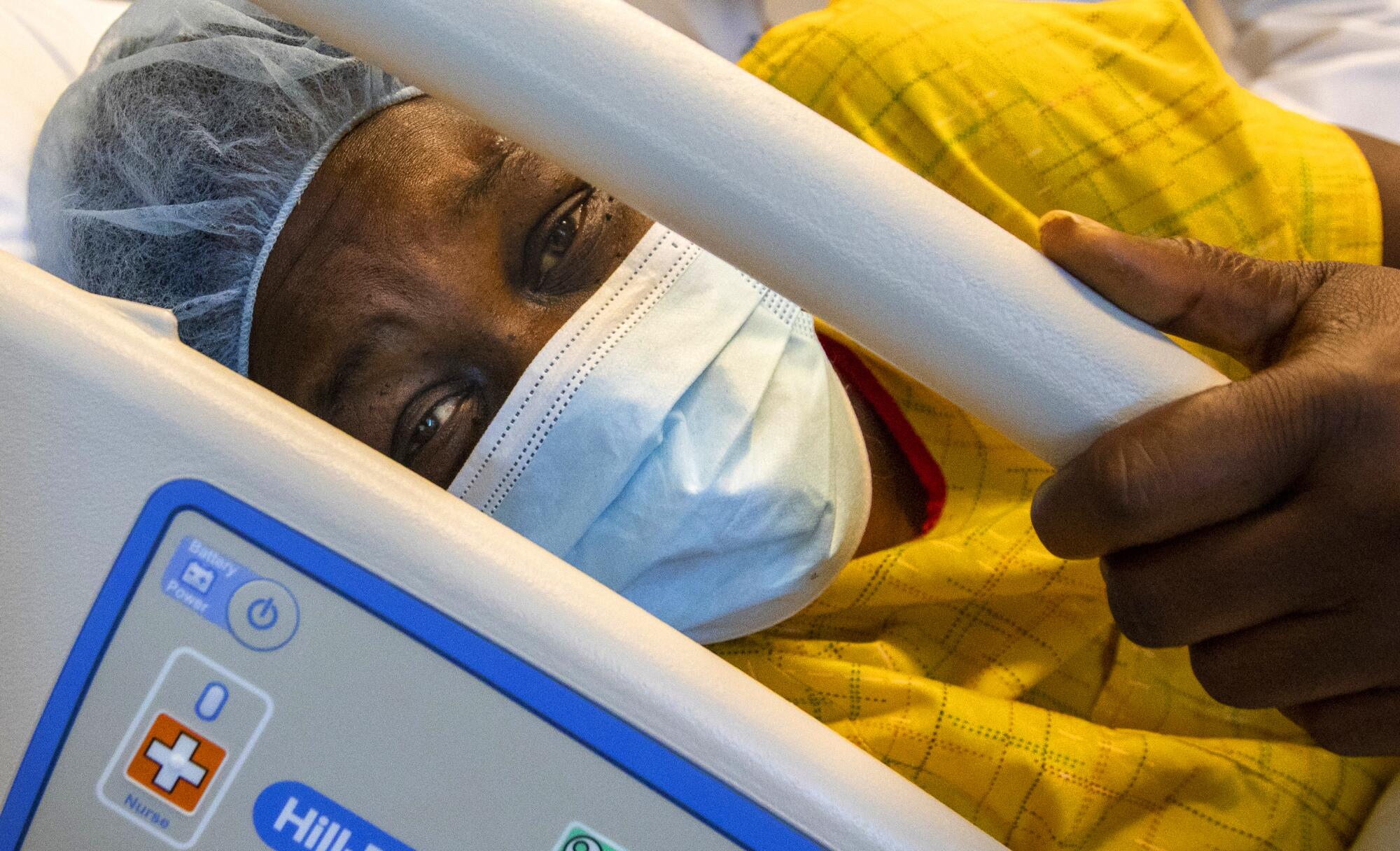
Her mother raised her and her two brothers in the Nickerson Gardens public housing complex in Watts. In the summer, they went to the beach. On warm nights, her mom and aunt would sit on the porch talking, and the kids would fall asleep on the lawn.
But her mother died of heart disease when she was 9. Paschal and her brothers were sent to live with different aunts and uncles. She went to high school in the Central Valley and came back to Watts during her senior year in 1986 without getting her diploma. The area’s economic backbone had been gutted by the closing of the auto factories, tire plants and steel mills that had provided solid blue-collar work since World War II.
Paschal found a job doing laundry at the Los Padrinos Juvenile Hall in Downey.
When she had her son Nelson, she qualified for federal aid. She raised the boy and his younger sister Keynna to be respectful to adults, say “yes ma’am, no sir.” They were diligent in school and kept out of gangs. She loved nothing more than escaping into old TV westerns like “Bonanza,” “The Big Valley” and “The Rifleman,” where the difference between good and bad was clear as day.
She mostly didn’t have a car and often ate at Hawkins House of Burgers across from her apartment because it was cheap and easily accessible, and the nearest supermarket carried old meat and stale produce. At age 32, she was diagnosed with diabetes and hypertension, and her long journey through the Medi-Cal system began.
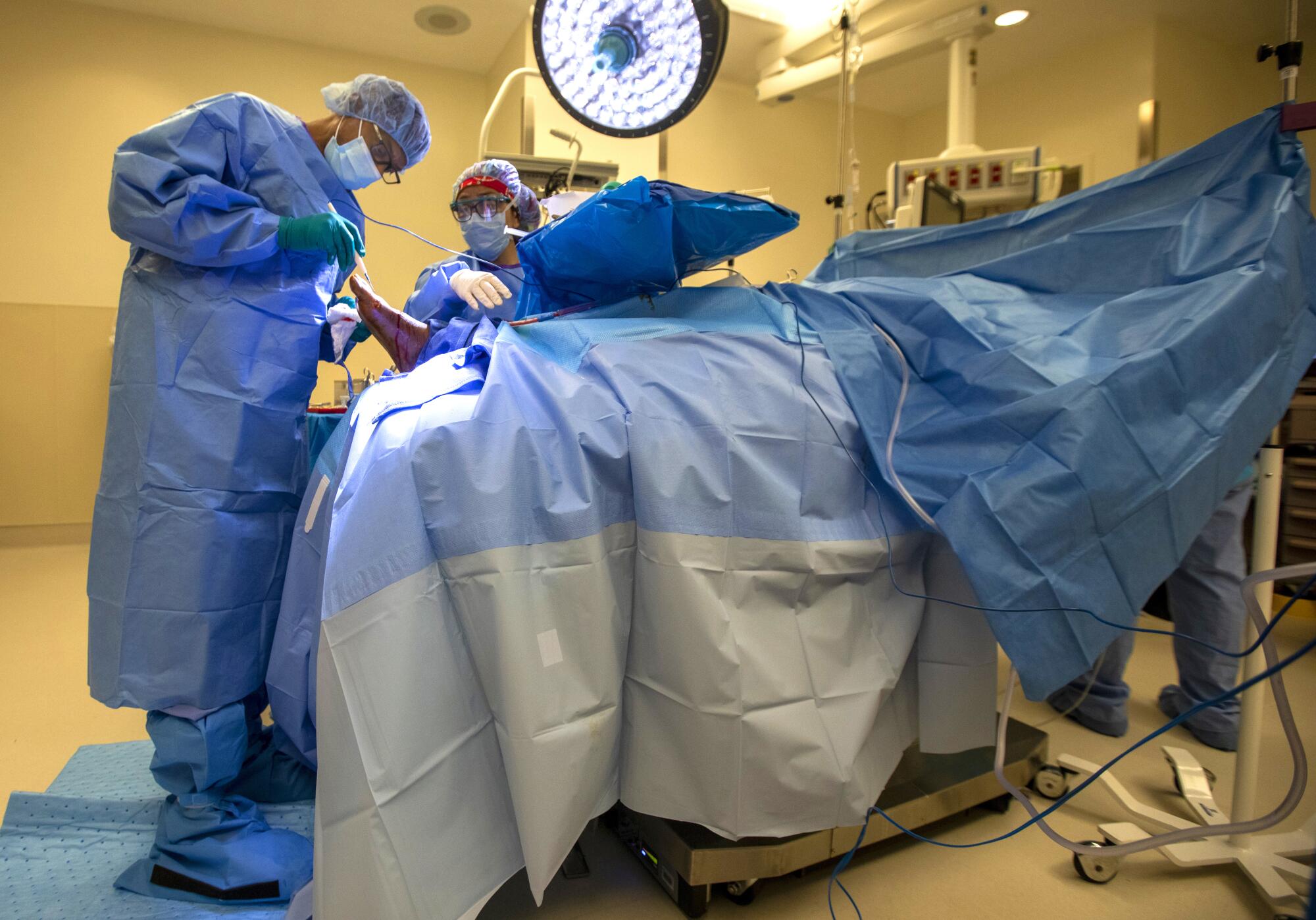
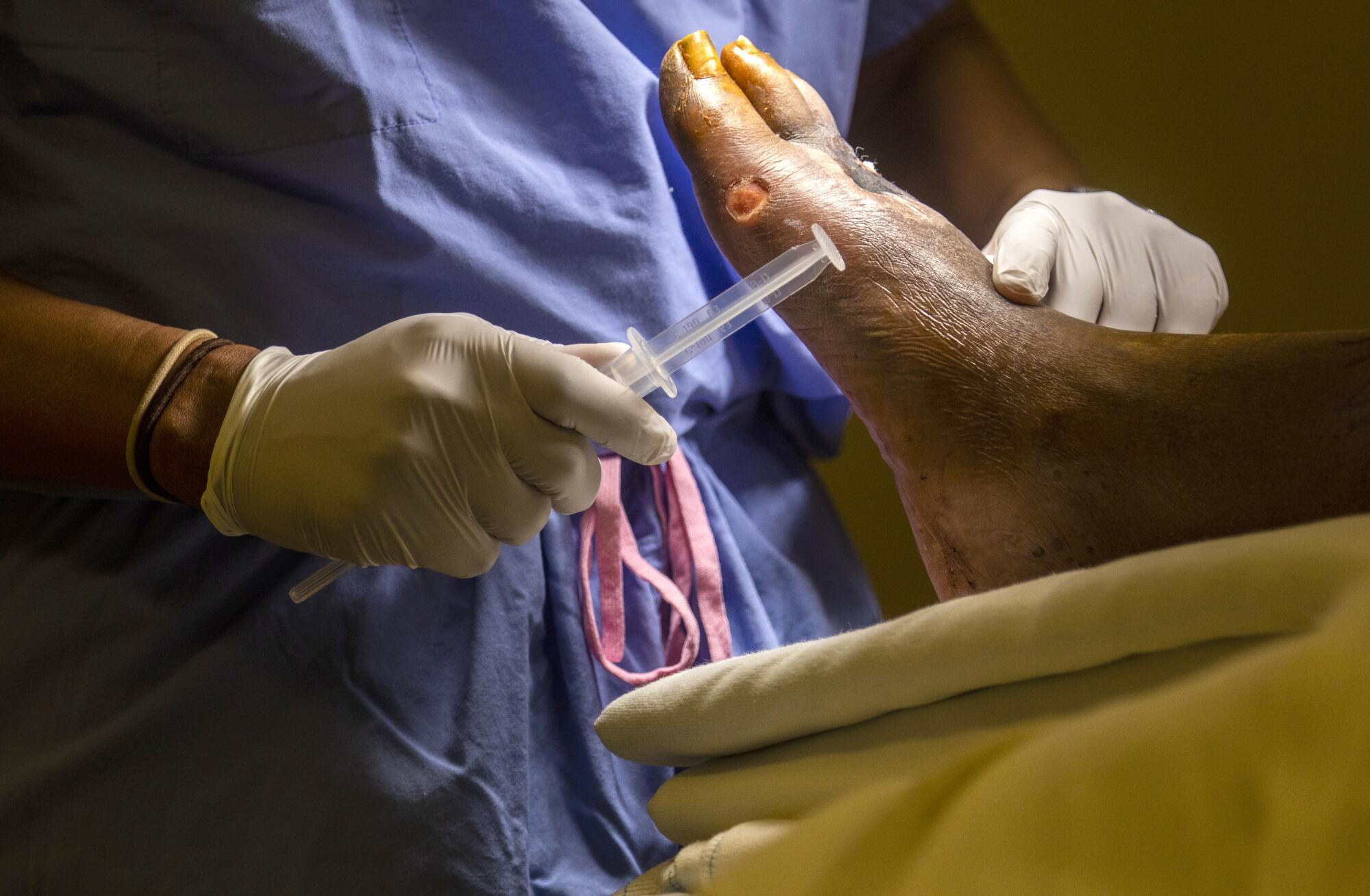
On May 21, she had large blisters on her foot, and Hall had to remove her two small toes. She didn’t have enough skin left to close the wound, so he left it open for the tissue to regenerate.
Every Wednesday after that, Nelson, now 27, drove his mom to the wound care clinic and wheeled her up to the second floor, towing his sister’s two little girls behind. He worked two 24-hour shifts every week as an emergency medical technician and took care of his nieces the other days.
“He’s the uncle, but he’s Uncle Daddy,” Paschal says.
The wound improved but on July 10 Paschal came to the ER for urogenital bleeding and tested positive for COVID-19. Her symptoms were mild at first, but her condition worsened fast. Within a week, she was on high-flow nasal oxygen at the maximum setting.
She said no to being put on a ventilator, sure she would die on it.
She struggled to breathe for weeks, and fell into a delirium, reliving a terrifying memory when she was thrown into a pool as a little girl, unable to swim.
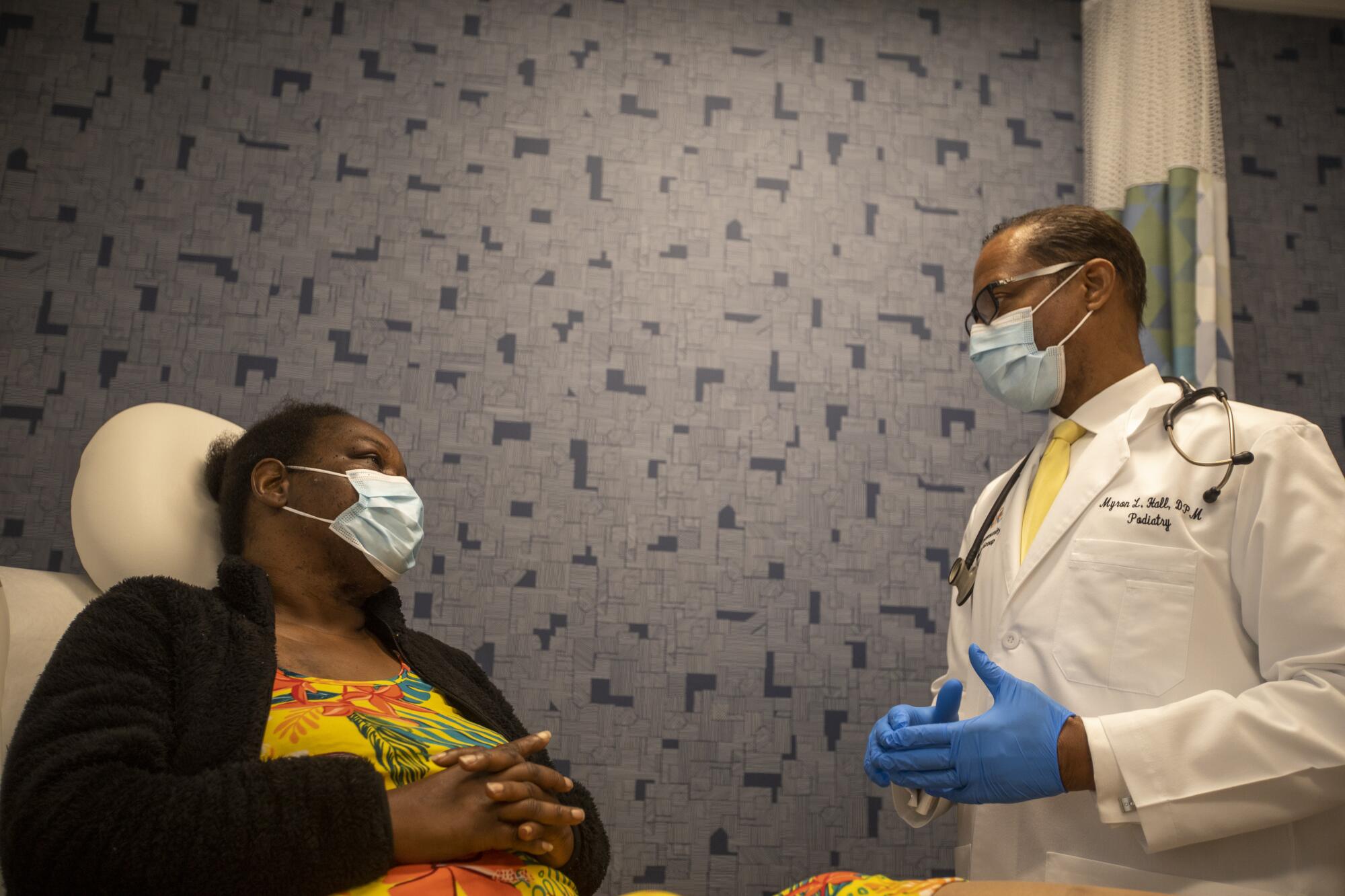
Her wound deteriorated as anti-inflammatory medications for COVID-19 compromised her immune response and her tissue was getting less oxygen. By August, she was recovering from the virus, but the foot infection was in the bone, where it could enter the bloodstream. Hall had to remove the rest of her toes to save her foot and her life.
After 54 days in the hospital, she bore the loss stoically, knowing Hall did all he could do.
In her apartment, her little granddaughters lift her spirits.
“Granny, it’s exercise time,” they call out, coming home from kindergarten.
They help her as she lifts her arms and legs.
She’s confident she’ll be able to walk again.
But she’ll forever resent her initial doctors’ lack of attention.
“I may as well have gone to Dr. Seuss.”
Watch L.A. Times Today at 7 p.m. on Spectrum News 1 on Channel 1 or live stream on the Spectrum News App. Palos Verdes Peninsula and Orange County viewers can watch on Cox Systems on channel 99.
More to Read
Sign up for Essential California
The most important California stories and recommendations in your inbox every morning.
You may occasionally receive promotional content from the Los Angeles Times.
